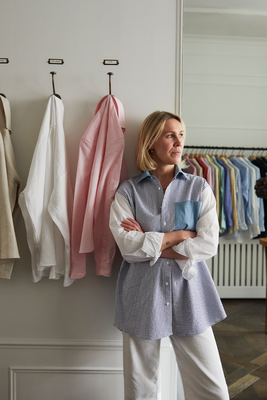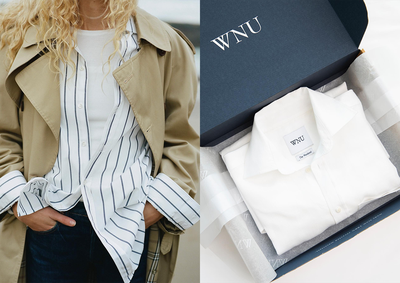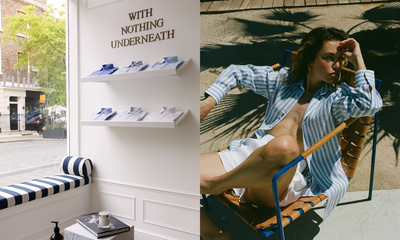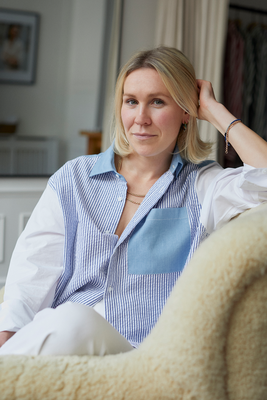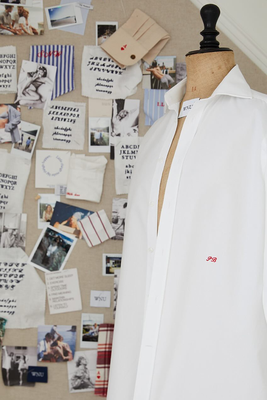
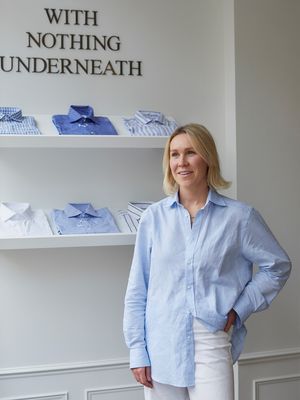
How To Do One Thing Really Well, With Pip Durell
All products on this page have been selected by our editorial team, however we may make commission on some products.
As a fashion journalist, I was around product all the time. You really get an insight, you're very much hands on and I remember thinking, why is all of it so expensive? For a good shirt, made from quality materials that had moved through an ethical supply chain – back then it was about £200 and now it would be about £400. At the time, the only alternative was going to the high street, and the quality and sustainability profiles were so different. I just wanted a good cotton shirt that I was willing to invest in but didn’t want to spend a fortune on. I suppose I spotted the gap in the market.
It was when I was at Tatler that I thought, why don’t I just make a shirt? I honestly treated it like a hobby. I took the bus to Twickenham on a Saturday to visit a factory I’d researched online, found this guy and asked him to make me a shirt. He made a great sample, but when I looked into getting them manufactured in the UK, I realised my goal of wanting to keep the price point around £100 just wasn’t going to be profitable. That’s when I came across the idea of manufacturing in Portugal.
I just Googled manufacturing in Porto and on about page 72 of Google, I found this guy, José. I emailed him, booked a flight, and got in his car at Porto airport. Looking back, it was ridiculous. I did a lot of bluffing – we went round a lot of mills and factories, and I pretended I knew what I was talking about. To get material running through a mill, you have to have a minimum amount of meterage, so I just did one shape in three colourways, and it went from there. We sold them and I realised people liked the product. So, we made some more and that’s how we ran things for a few years. Two years in, I made the commitment to take it from a hobby to a business – it was time to sink or swim.
What turned things around for us was when Meghan Markle wore our shirts. The first time was in a behind the scenes video for Smartworks, and then she went to a meeting at a bakery and that image made it to the front cover of The Telegraph. It gave us amazing international growth – and a huge leg up along with a cash injection. That said, it’s all well and good when someone opens the door for you like that, but you still have to have the skills and ability to walk through it. If we weren’t going to make it, we’d still have fallen flat on our face – and by that, I mean if the product isn’t good, it won’t succeed, even if Kate Middleton is wearing your pieces day in, day out.
The key was to capitalise on this moment. The duchess was a customer, it wasn’t a press gift – and it proved she was keen to support British businesses. Plus, the fact she was wearing the shirts time and again suggested she really liked them, too.
At the beginning, I put in £7,500 and we've never taken a penny from anyone else since. The whole business is organic – nothing gets put in and not much gets taken out. Everything we make gets put back in, which is why our team and production arm are still relatively small. We’re extremely narrow and very focused. We buy deep, but we don't go wide. For example, our two new hemp colours this season have joined the ones we already have. They sold out when we first introduced them at Christmas, so we knew people liked them, which is why we’ve expanded the colourways. Like I say, it’s not about going wide – it’s about offering more options within something you know your customers already want.
Because we're direct to consumer, we know exactly what our customer wants. We hold so much knowledge – and it’s why we only do limited drops with department stores. We want control over the product, the quality, the presentation, the way our team is trained etc. And the way we speak to our customers is so unique – we don’t put women in boxes, there really is something for everyone in the range, even though it’s pretty tightly curated. There are shirts that will work for school drop off, the office, drinks with friends. Loose cuts, classic cuts, cuts for bigger busts – because we’ve only focused on the one product, we can tweak it to make sure we’re meeting our customers’ needs.
I have so many references in my mind. The most important is probably Jackie Kennedy getting off the boat in Capri, in a little cropped white jean, a shirt and a headscarf. She was the chicest woman on the planet. Once people find us, and find their preferred shape of shirt, they just repeat buy – our customer engagement is through the roof. We’re not trying to reinvent the wheel and it’s not even hard because we’re not trying to be perfect. The price point is also spot on for a lot of people – especially when it’s matched with the quality we offer.
Bricks and mortar has been so successful for us. When I look back at so many decisions I've made over the last few years, I can't believe I made some of the riskier ones. But, today, it’s like you move or you die – stand still and you're dead in the water. I’m mixing metaphors but you have to keep moving and doing what's next. We had our website first, so we knew there was demand, and opening a store was really about servicing that demand. Now, people can see and feel the quality. They can try the shirts on, understand what shapes are best for them, and then they'll often convert to an online customer.
Before we even had the website, WNU had an Instagram account – which was essentially a moodboard. When I made that public and started adding people, they loved the aesthetic – this sort of undone, sexy, cool, Brit girl. We garnered a big following because people liked what they saw and now that's translated to our shoots and marketing. Of course, the product has to be good, but if you don’t know how to market it, you're not going to get anywhere. Luckily, my background is shoots and storytelling – so while we’re customer-led, we always have this editorial head on.
Even today we can't take big risks – we haven't got anyone to back us up. But there’s something quite rewarding about doing this slow and steady – especially in today's world. It’s kind of our entire ethos anyway. Sure, we do one sample sale a year so as not to waste the sample materials, but otherwise we don’t do markdowns. If an average brand looks for a 60% sell-through and then sell 40% of their stock on sale, we look for a 90% sell-through. We want to shift all the stock by the end of the season.
I'm really inspired by Orlebar Brown. What Adam has built there is amazing. He started with swimming trunks and has built an entire brand around the concept of a holiday. Swimming trunks will always be their key focus, but the customer can now go in and buy the whole outfit. We're always going to be focused on shirting, but our consumer wants more from us. If you do the shirt so well, why wouldn't you do a tailored trouser? Why wouldn't you do a jacket? But we have to do that thoughtfully.
Becoming B Corp certified wasn’t something I set out to achieve at the beginning. But, once we were really up and running, I knew that we needed to run the business better. Being a sustainable business hits your margins massively but it’s the only way forward and the only way to consciously build a consumer business. There’s amazing trust that comes with that. Trust is a word we talk about a lot – it’s why people come back to us.
It's a big mistake to underestimate your consumer. Ours knows exactly what she likes, she knows quality and they're going to be looking at you closely. Reputation really is everything in this business – and I think it has a lot to do with why we were able to report 130% growth in sales last year. It proves that the format is working.
Scaling is probably our biggest challenge. I want to continue nurturing the team, making sure we remain on brand at all times, but I can’t have the same touch points I used to. So, ensuring the next level below me understands the core values of the brand and how we want to do business…well, sometimes there are going to be growing pains. Everything's a learning curve – especially because I don’t come from a business or branding background.
Having a successful business really comes down to grit. I have never worked harder, and I’m not complaining but sometimes people think working for yourself is flexible and easier than working for someone else. I see my baby less than anyone else – I'm always travelling or sacrificing something. But to make this a success, I have to give it 365 days of the year. If I didn’t give it that level of dedication, we wouldn’t be here. So, other people looking to launch a brand need to know this: it's hard work and you have to be ready to put in every hour.
I’m really open to whatever is next for us. Maybe we'll get funding, maybe we won't. Either way, the future is full of possibilities. Our international growth is very strong – there’s lots of momentum and that's probably going to be a big focus for us. We need to make sure we're retaining our core branding while also understanding the consumer landscape in a different country, which won’t be easy. But we have a lot to work with and it’s very exciting.
DISCLAIMER: We endeavour to always credit the correct original source of every image we use. If you think a credit may be incorrect, please contact us at info@sheerluxe.com.
